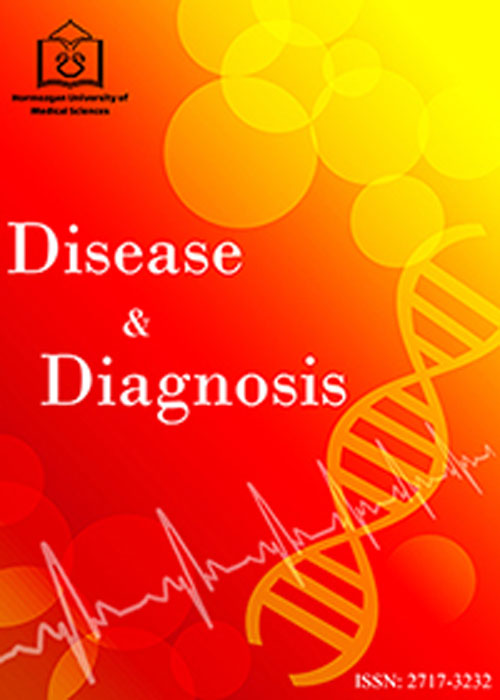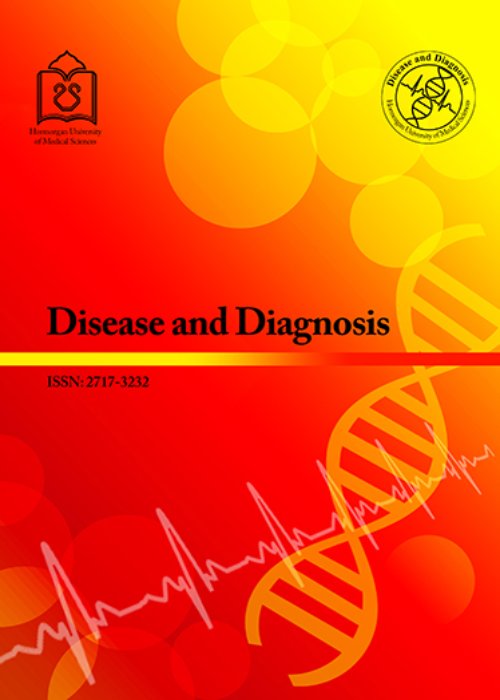فهرست مطالب

Journal of Disease and Diagnosis
Volume:10 Issue: 4, Dec 2021
- تاریخ انتشار: 1400/11/04
- تعداد عناوین: 8
-
-
Pages 132-134
Following the outbreak of novel coronavirus disease 2019 (COVID-19), there have been debates among scientific communities, officials, and the public about the role of the mask in controlling and preventing this disease. Nonetheless, there are some ambiguities regarding various aspects of the mask which are still important to be addressed, including the type of the mask to be used, the situation in which the mask should be used, the correct way to use the mask, and the effectiveness of the mask in preventing the disease. Accordingly, addressing these ambiguities could change policy trends and public beliefs about the use of mask and help control the disease. To this end, this study discusses the role of the mask in preventing and controlling the COVID-19 pandemic.
Keywords: COVID-19, Cloth mask, N95 respirators -
Pages 135-143Introduction
Acute Respiratory Syndrome Coronavirus 2 (SARS-CoV-2), which began in late 2019 in Wuhan, China, has become a global epidemic. Angiotensin 2 converting enzyme (ACE2) acts as a receptor for host function to cause acute coronavirus 2 acute respiratory syndrome (SARS-CoV-2). ACE2 is abundantly expressed in different cells of different human organs. In human physiology, ACE2 is a major player in the renin-angiotensin-aldosterone (RAAS) system by degrading angiotensin II. Many factors have been associated with altered ACE2 expression and the severity and progression of COVID-19, including microRNAs that may be effective in it. Identifying pathological changes due to SARS-CoV-2 infection is important because it has major implications for understanding the pathophysiology of COVID-19 and developing evidence-based treatment strategies. Currently, many intervention strategies are being explored in ongoing clinical trials.
ObjectiveThe aim of this study is to use bioinformatics databases to find potential antiviral therapies against SARS-CoV-2 through host microRNAs (miRNAs) that can reduce viral gene expression to inhibit virus entry and replication.
MethodsUsing different algorithms in TargetScan, DIANA, ENCORI and miRWalk databases, the potential microRNAs were identified that target ACE2. Then, a score table was prepared from the candidate microRNAs, based on the affinity of the seed region of microRNAs and the 3`-UTR region of the ACE2 gene. Finally, microRNAs with higher scores were chosen as candidates for practical analysis.
ResultsThe results of Bioinformatical analysis showed that Has-miR-200c-3p, Has-miR-29a, HasmiR-29c, and Has-miR-942 are most likely to inhibit ACE2. These microRNAs are the most potent factors that might be affected on ACE2 during virulence.
ConclusionIt seems that ACE2 is under the control of the miR-200c-3p and plays a crucial role in the pathophysiology process. Therefore, this microRNA can be considered as a suitable new candidate for experimental evaluation.
Keywords: SARS-COV-2, COVID-19, ACE2, microRNA, miRNA -
Pages 144-154Background
To promote mitigation strategies and public health response, this study aimed to evaluate the population-based seroprevalence of anti-severe acute respiratory syndrome coronavirus 2 (SARS-CoV-2) antibodies in Hormozgan province.
Materials and MethodsThe study was conducted within 10 districts of Hormozgan province with 1325 participants for three months by considering three-month successive follow-ups to evaluate the durability of humoral immunity. The participants completed the questionnaire, and blood samples were taken followed by immunoassay SARS-CoV-2 ELISA testing.
ResultsIn general, 717 (54.1%) males and 596 (45.9%) females participated in this study. In phase one, 147 (11.1%) and 182 (14.7%) tested positive for immunoglobulin M (IgM) and IgG, respectively. Upon three months, 13.8% and 17.8% tested positive for IgG and at least for one of the antibodies. Based on the results, 606 (45.7%) cases reported no symptoms while 673 (50.8%) of them reflected at least one. Among 798 (60.2%) participants, the most common symptoms were headache (n = 244, 18.4%), sore throat (n = 186, 14.0%), weakness (n = 150, 11.3%), muscular pain (n = 139, 10.5%), and sputum cough (n = 134, 10.1%). The odds of the antibodies in females was 1.37 (95% CI: 1.03, 1.82, P = 0.03). In phase 2, 43 (5.3%) participants persisted positive for IgG while 559 (73%) tested negative for IgG. Finally, 20% of the suffered participants tested positive for IgG until nine months.
ConclusionAlthough IgG antibodies decreased in the first six months, their titers persisted stable for nine months. It seems our population has not reached a desirable level of protection. It is stressed that mass vaccination is needed to prevent future epidemic waves.
Keywords: COVID-19 pandemic, Humoral immune response, Seroepidemiologic study, Antibodies -
Pages 155-163Background
Today, with the spread of tobacco use and increased environmental pollutions, respiratory diseases are considered important factors threatening human life. Chronic obstructive pulmonary disease (COPD) is a kind of inflammatory lung disease. Clinically, COPD is currently diagnosed and monitored by spirometry as the gold-standard technique although spirometry systems encounter some limitations. Thanks to the economical handling and sampling, practicality, and non-invasiveness of saliva biomarkers, it is promising for the testing environment. Accordingly, the current analytic observational study aimed to propose an intelligent system for COPD detection.
Materials and MethodsTo this end, 40 COPD (8 females and 32 males in the age range of 71.67±8.27 years) and 40 controls (17 females and 23 males within the age range of 38.23±14.05 years) were considered in this study. The samples were characterized by absolute minimum value and the average value of the real and imaginary parts of saliva permittivity. Additionally, the age, gender, and smoking status of the participants were determined, and then the performance of various classifiers was evaluated by adjusting k in k-fold cross-validation (CV) and classifier parameterization.
ResultsThe results showed that the k-nearest neighbor outperformed other classifiers. Using both 8- and 10-fold CV, the maximum classification rates of 100% were achieved for all k values. On the other hand, increasing the k in k-fold CV improved classification performances. The positive role of parameterization was revealed as well.
ConclusionsOverall, these findings authenticated the potential of machine learning (ML) algorithms in the diagnosis of COPD using subjects’ saliva features and demographic information.
Keywords: Chronic obstructive pulmonary disease, Saliva, Machine learning, Diagnosis -
Pages 164-168Background
Pregnancy is one of the most critical periods in the life of most women. Since it is necessary to be aware of the health of the mother and fetus, serum markers (i.e., glucose and urea) need to be monitored during pregnancy. A routine strategy in this area is venipuncture which is applied to measure the level of these markers. It is also a stressful procedure for pregnant women. The purpose of this study was to determine the salivary level of these markers as a stress-free method in pregnant women.
Materials and MethodsThe samples were collected from 30 pregnant and 30 non-pregnant fasting women. Then, the serum and salivary levels of glucose and urea were measured, analyzed, and compared by photometry.
ResultsResults indicated that the mean salivary glucose level was 10.2±1.4 mg/dL and 6.4±0.9 mg/ dL in non-pregnant and pregnant women, respectively. In addition, the mean serum glucose level was 106.5±5.3 mg/dL and 82.9±4.5 mg/dL in non-pregnant and pregnant women, respectively. Further, the mean salivary urea level was 37.1±3.3 mg/dL in non-pregnant women and 27.1±1.9 mg/dL in pregnant women. Moreover, the mean serum urea level was 26.9±1.9 mg/dL and 19.5±2.3 mg/dL in non-pregnant and pregnant women, respectively.
ConclusionSerum and salivary levels of glucose and urea in pregnant women were lower than those in non-pregnant women, and there was a positive correlation between serum and salivary levels. Therefore, it seems that saliva can be a substitute for serum regarding the measurement of glucose and urea levels.
Keywords: Saliva, Urea, Glucose, Pregnant -
Pages 169-176
Cryptosporidium species are important intestinal pathogens with widespread distribution in humans and other hosts. Whereas the parasite causes acute and self-limiting gastroenteritis in people with healthy immune systems, many reports on this infection around the world are limited to people with defective or suppressed immune systems who suffer from a persistent and deadly infection. Using laboratory-serological and molecular methods for the detection of Cryptosporidium species in immunocompromised and healthy human samples, recent studies in Iran indicated that the prevalence of Cryptosporidium species in different samples varied between 0 to 14%. The samples in Iranian studies included human fecal and diarrheic samples from diarrheic children, patients with gastroenteritis, immunocompromised individuals, and people in contact with livestock. Furthermore, some species were reported based on molecular studies including Cryptosporidium parvum and Cryptosporidium hominis. Some studies have also reported Cryptosporidium meleagridis. In this review study, data were collected regarding the prevalence of cryptosporidiosis in high-risk individuals such as children and immunocompromised individuals. The results revealed that the higher prevalence of C. parvum in Iranian studies in the last 10 years may be attributed to the transmission of infection from animal sources.
Keywords: Cryptosporidium species, Health human samples, Immunocompromised individual, Diarrheic children, Iran -
Pages 177-179Background
Turner syndrome occurs in nearly one in every 2000-5000 female births. This syndrome is a genetic problem in the female phenotype and the most common sex chromosome anomaly. It is diagnosed based on clinical manifestations and cytogenetic examinations. The classic syndrome (i.e., monosomy X) makes up 50% of the cases while other forms contain X chromosome variants, which do not typically manifest as the classic X phenotype.
Case PresentationThis study, presents a rare variant of Turner syndrome reported in a 20-year-old woman presenting with primary amenorrhea, hypothyroidism, and short stature who had hypergonadotropic hypogonadism with hypoplastic ovaries while without the clinical manifestations of the classic Turner syndrome. The karyotype was determined as X isochromosome-X syndrome [46 XXi (Xq)].
ConclusionThis rare syndrome occurs in approximately 7% of the cases of Turner syndrome. Rare variants of the syndrome should also be considered in female patients without the classic manifestations of Turner syndrome.
Keywords: Turner syndrome, Amenorrhea, X isochromosome-X syndrome -
Pages 180-182Background
Long-term use of central venous catheters is common in cancer patients for chemotherapy. The remaining of these catheters after the end of the treatment period can be associated with complications such as thrombosis and catheter fragmentation.
Case ReportThis report presents a 42-year-old woman with a history of colon cancer whose inner part of the vascular access was detached from the outer part after removing the central venous catheter, and the catheter remained inside the internal jugular vein. After preparing the patient’s chest X-ray, the catheter was removed from the femoral vein by percutaneous retrieval and successfully taken out using the snaring technique.
ConclusionOverall, percutaneous retrieval is a safe way to remove intravascular foreign bodies that can prevent major surgical complications.
Keywords: Port-a-cath, Percutaneous retrieval, Snare


